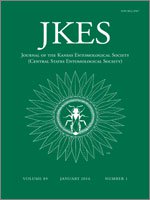Green June beetle, Cotinis nitida (L.), is an important pest of grapes, peaches, blackberries, blueberries, apples, and pears, yet cumulative degree days that this species requires for outbreak have not been delineated. We monitored green June beetle populations in Mountain Grove, Missouri, USA, for five consecutive years (2009–2013) using traps baited with isopropanol. Our results show that cumulative degree day (CDD) calculation with starting point of March 1st, single sine method of calculation, and 10°C as the base temperature may be used for forecasting green June beetle population dynamics. Five year average ± SE was 888.96 ± 36.78 CDD for the first catch of the green June beetle and 1237.68 ± 25.31 CDD for peak trap catch. Our data also suggest that in the relatively rainy environment in Mountain Grove, the departures from the five year average observed in a given year were not correlated with precipitation preceding the first flight and peak activity of green June beetle populations.
How to translate text using browser tools
1 January 2016
Predicting Emergence in a Midwestern Population of the Green June Beetle, Cotinis nitida (L.) (Coleoptera: Scarabaeidae)
Cory Creed,
Brian Cowell,
Donn T. Johnson,
Maciej A. Pszczolkowski
ACCESS THE FULL ARTICLE
cumulative degree days
insect emergence
isopropanol
Pest beetles
trapping





